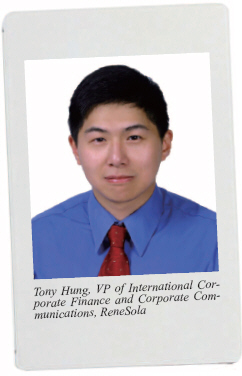ReneSola is a Jiashan-headquartered solar wafer manufacturer. In 2011, ReneSola announced it had developed a new multicrystalline wafer, the Virtus Wafer, achieving an average cell conversion efficiency rate of 17.5%, more than 1% higher than the industry-standard cell conversion efficiency rate for cells using multicrystalline wafers.
In this interview with InterPV, Tony Hung, VP of International Corporate Finance and Corporate Communications at ReneSola, discusses the company’s wafer technology.
Reported by Stella Y. Lee (pved1@infothe.com)
.jpg)
 Does ReneSola have any specific timeline to expand solar wafer manufacturing to become a fully vertically integrated solar company? Does ReneSola have any specific timeline to expand solar wafer manufacturing to become a fully vertically integrated solar company?
We don’t have a specific timeline per se, but as we have been primarily a wafer manufacturing company, with currently 2.0 GW of wafer capacity, 240 MW of cell capacity, 400 MW of module capacity, and 3,500 MT of poly capacity, the wafer capacity would not need to be further expanded to increase the degree of vertical integration. However, we are looking at the possibility of additional vertical integration in other areas, and we have announced plans to increase our polysilicon capacity.
What is it that you’re doing now, and what makes it unique?
We are doing several things which are unique in the industry. First, we’re the first company to be mass-producing the mono-like multi wafers, what we called our Virtus wafers. These are high efficiency multi wafers that benefit from the cheaper costs of the multi process but have higher efficiencies closer to mono wafers. Also, we are continuing to work on our polysilicon product. Compared to other vertically integrated players, we are the only ones who have successfully started polysilicon production at a reasonable cost level, and are continuing to drive down costs aggressively. Over time, we hope to become a low cost, high tech, vertically integrated solar company with our own in-house polysilicon.
What special manufacturing processes are required to build the wafers, solar ingots, and solar cells?
We take molten polysilicon and cast into a block, or melt raw polysilicon and then rotate it into an ingot, and then after pulling the block/ingot, we then cut the material into wafer slices which are then cleaned and dried.
Could you give an explanation about Virtus wafer introduced in January 2011? What is the core technology in it?
We cannot disclose too much details about the technology, but by improving the manufacturing process, modifying furnaces, and using some of our in-house technical know-how, we can substantially improve the efficiencies of a typical multi wafer in order to create the Virtus wafer.
 Additional expenses of over US$10 million will be incurred to upgrade current wafer production capacity. Costs in Q3 will rise 1 to 2 cents per chip. But, how about Virtus wafers & modules? Additional expenses of over US$10 million will be incurred to upgrade current wafer production capacity. Costs in Q3 will rise 1 to 2 cents per chip. But, how about Virtus wafers & modules?
Typically, Virtus wafers only cost about 1 cent per per watt. So as of the last conference call, the Virtus processing cost was approximately US$0.19/watt.
ReneSola has shut off production of 200 MW monocrystalline silicon. Do you believe that monocrystalline silicon will be replaced soon?
Last year, demand was quite good for monocrystalline products. As such, it currently does not appear that monocrystalline will be replaced soon. However, we still believe that as soon as the efficiencies for mono-like multi wafers can become only negligibly different from mono wafers, mono will be phased out over time. Regarding our 200 MW capacity, it was only temporarily shut off.
Where will most of your wafers end up? Will they go to manufacturers in the U.S.A.? In Europe? Or Asia?
As disclosed in our annual report, our key market is in China. As we are a producer of wafers, an intermediary product, we will be selling quite often to top-tier manufacturers, many of whom are based in China.
Stella Y. Lee is Editor of InterPV. Send your comments to pved1@infothe.com.
For more information, please send your e-mails to pved@infothe.com.
ⓒ2011 www.interpv.net All rights reserved.
|


